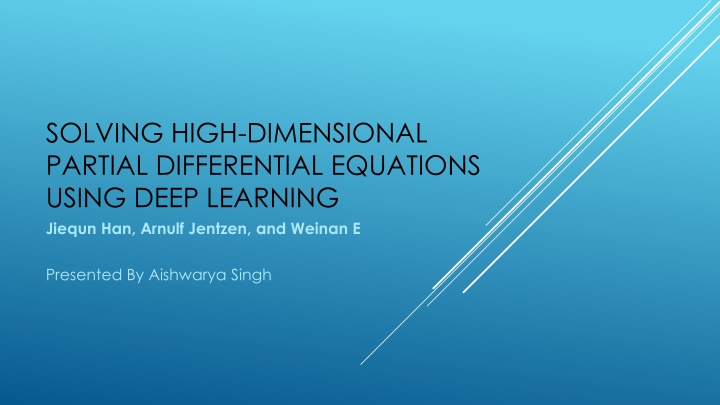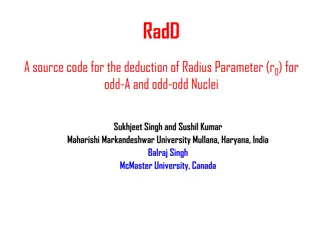
Solving High-Dimensional PDEs Using Deep Learning for Finance and Beyond
Learn how neural networks are revolutionizing the solution of high-dimensional partial differential equations in finance and other fields, overcoming the Curse of Dimensionality. Discover the power of deep learning in modeling complex dynamic systems and the impact on numerical algorithms for PDE-based modeling.
Download Presentation

Please find below an Image/Link to download the presentation.
The content on the website is provided AS IS for your information and personal use only. It may not be sold, licensed, or shared on other websites without obtaining consent from the author. If you encounter any issues during the download, it is possible that the publisher has removed the file from their server.
You are allowed to download the files provided on this website for personal or commercial use, subject to the condition that they are used lawfully. All files are the property of their respective owners.
The content on the website is provided AS IS for your information and personal use only. It may not be sold, licensed, or shared on other websites without obtaining consent from the author.
E N D
Presentation Transcript
SOLVING HIGH-DIMENSIONAL PARTIAL DIFFERENTIAL EQUATIONS USING DEEP LEARNING Jiequn Han, Arnulf Jentzen, and Weinan E Presented By Aishwarya Singh
INTRODUCTION: Partial Differential Equations are a ubiquitous tool to model dynamic multivariate systems in science, engineering and finance. PDEs are inherently multidimensional by the definition of partial differentiation. Solving a PDE refers to the extraction of an unknown closed-form function of multiple variables (or an approximation thereof) from a known relation between the dynamics of some of these variables (the PDE), and some boundary conditions. Stochastic PDEs are thought of as a generalization of regular (deterministic) PDEs.
PARTIAL DIFFERENTIAL EQUATIONS IN FINANCE: The Black-Scholes Equation is likely the most famous PDE in finance. The Hamilton-Jacobi-Bellman Equation (HJB) is also a prominent PDE for dynamic asset allocation in an actively trading portfolio. Han et. al. have taken on the challenge of solving extremely high dimensional versions of these PDEs using a Neural Network approximation method.
MOTIVATION THE CURSE OF DIMENSIONALITY: The Curse of Dimensionality (as coined by Richard Bellman in 1957) is an issue seen when increasing the numbers of objects being modeled in any system. A quantum physical system with many particles. A biological system with many genes. A financial system with many assets. This issue is most often referred to in data mining and combinatorics contexts. In the context of PDE-based modeling, the curse refers to the explosion in computational costs for numerical algorithms, which often need to be used when analytical solutions are unavailable.
NEURAL NETWORKS INTRODUCTION: Neural Networks are a family of algorithms that can be used to create powerful models for regressions or classification problems on high-dimensional data. Neural Networks are compositions of simple functions that ultimately approximate a much more complex function. Neural Networks are very heavily parametrized with huge numbers of weights that are optimized for simultaneously.
NEURAL NETWORKS BASICS: A perceptron (aka. artificial neuron ) is the building block of a Neural Network. A perceptron feeds the dot product of a vector of inputs and a vector of weights into an Activation Function. An Activation Function mimics the firing of a biological neuron. The output is negligible until the input reaches a certain threshold, thus producing a nonlinear micro-model. Popular activation functions are the step function, smoothed step (sigmoid) function, linear rectifier, and smoothed rectifier ( softplus function). Image Credit: towardsdatascience.com Each layer of a Neural Network consists of several parallel perceptrons typically processing the same inputs, but with different weights.
MULTILAYER NETWORKS DEEP LEARNING: Neural Networks consist of an input layer which simply distributes input vectors, an output layer which collates outputs, and one or more hidden layers which construct and store a model. Feed-Forward refers to the architectural property of most NNs where hidden layer outputs will act as inputs for subsequent hidden layers, composing their perceptrons and weights on top of one another. Deep Learning refers to the use of NNs with many layers and complex architectures. Image Credit: neuraldesigner.com
LEARNING THROUGH OPTIMIZATION GRADIENT DESCENT : Each output of a Neural Network is ultimately a huge composition of perceptron functions and weights. Neural Networks are trained by comparing these outputs to a target value (training data) and minimizing a Loss Function between them. Sum-of-Squared-Errors is a popular general-purpose Loss Function. A gradient can be defined for an NN output function, and for the output functions of any given NN layer, based on the Activation Functions used by the component perceptrons. Gradient Descent is an optimization algorithm wherein weights across a layer are simultaneously altered in steps (with step size based on an exogenous learning rate parameter) in order to reduce the Loss Function. Backpropagation refers to the process of cascading the weight-updating process backwards from a final Loss Function to the first hidden layer in a network, in order to train weights across all layers.
METHODOLOGY - SEMILINEAR PARABOLIC PDE: Han et al. consider a highly general class of PDEs called semilinear parabolic PDEs as the target of their NN-solver algorithm. The general form for these equations is as follows: t is time. x is a d-dimensional space. mu is a vector-valued unknown function being sought. sigma is a known dxd-matrix-valued function. f is a known nonlinear function. nabla refers to the gradient, or first derivative vector, of mu w.r.t t and x . The Hessian is the matrix of second derivatives of mu w.r.t t and x . A Trace is a summation of diagonal elements of a matrix.
METHODOLOGY - BACKWARDS STOCHASTIC PDE: Han et al. substitute the d-dimensional deterministic variable x with a random variable X which varies in time based on the following stochastic process: This implies that the solution to the semilinear parabolic PDE will be of the form: which is a Backwards Stochastic Diff. Eq. (BSDE)
METHODOLOGY - BACKWARDS STOCHASTIC PDE: The next step is to Euler-discretize the BSDE in time: This discretization allows sample paths of random variable X to be easily generated. The initial values of the mu function and its gradient are treated as model parameters.
METHODOLOGY NEURAL NETWORK APPROXIMATION: The randomly-generated X values are used to train sub-networks seeking to find an approximate function that conducts the following mapping at each time step: This approximate function is defined in the terms of a multilayer feed-forward networkwith parameters theta : These sub-networks for each time step are then stacked into an overall network architecture whose goal is to approximate the function mu , i.e the solution to the original PDE. The final Expected Loss Function takes the form:
CASE 1BLACK-SCHOLES WITH DEFAULT RISK: The basic case of Black-Scholes considers a single underlying asset that is not itself contingent on anything else; the underlying cannot default. Han et. al. consider a Black-Scholes PDE for the pricing of a European derivative based on 100 underlying assets which are conditional on no- default. Default risk is modelled as the first jump in a Poisson process with a level- dependent intensity Q and asset recovery rate given default delta . The final PDE for the option price mu is: x is a 100-dimensional vector. Most params (sigmas, delta, R, etc.) are exogenous.
CASE 1 RESULTS DISCUSSION: Shown is a plot of time-0 option price as generated by the NN- approximation, given that all 100 assets have a price of 100. The blue line is the mean and the shaded area the standard deviation of 5 independent runs. 40 time steps and a learning rate parameter of 0.008 are used. The price converges to a value of ~57.3 given enough optimizer iterations.
CASE 2HJB EQUATION: Han et al. consider a 100-dimensional control problem wherein a cost functional is to be minimized. The related HJB Equation is as follows: lambda is a positive constant for control strength. This PDE can actually be solved explicitly, given a function g(x) as a terminal condition at time T for mu(t,x) : Han et al. choose the following terminal function: The resulting solution is used as a benchmark against which to test the BSDE NN approximation algorithm.
CASE 2 RESULTS DISCUSSION: The blue line and shaded region again represent mean and standard dev. across 5 independent runs. The BSDE NN achieved a relative error of 0.17% in 330s on a Macbook Pro, when calculating optimal cost for all-0 inputs. 20 time steps and a learning rate of 0.01 are used. The Deep BSDE Solver is compared to Monte Carlo runs of the explicit solution (which has a Brownian noise input), across different values for the control strength parameter lambda . An intuitive decrease in optimal costs as control strength increases is observed.
CASE 3ALLEN-CAHN EQUATION: The Allen-Cahn Equation is a reaction-diffusion equation in physics. Reaction- diffusion equations are relevant in fields ranging from chemistry and molecular biology to materials science and electronics engineering. Once again, Han et al. consider a 100-dimensional case: with initial condition A relative error of 0.30% was achieved in 647s, using 20 time steps and learning rate 0.0005.
OVERALL RESULTS DISCUSSION: For the Black-Scholes case, the benchmark used for comparison was a no- default-risk 100-dimensional system, handled by Monte Carlo methods. The benchmark asset price was 60.781, against the BSDE NN s with-default model s ~57.300. For the HJB case, an explicit solution for the PDE with a noise input run through Monte Carlo sampling was used as a benchmark. For the Allen-Cahn case, a numerical solution produced by another BSDE- related algorithm, the branching diffusion method, was used for comparison. All runs were done on a Macbook Pro with a 2.9 GHz Intel Core i5 CPU and 16 GB RAM. An attempt to address the quantum many-body problem in physics did not succeed due to difficulty related to the Pauli Exclusion Princple.
DEEP LEARNING NETWORK ARCHITECTURE: Architecture was implemented using TensorFlow with the Adam Stochastic Gradient Descent optimizer.
DEEP LEARNING NETWORK ARCHITECTURE: Each time step has an associated fully-connected sub-network. Each sub-network has a d-dimensional input layer, 2 (d+10)-dimensional hidden layers and a d-dimensional output layer. The Activation Function is the linear rectifier (the perceptrons in this case are referred to as Rectified Linear Units ReLUs). Another reaction-diffusion PDE with an explicit oscillating solution was used to test the effects of having a different number of hidden layers. The number of hidden layers per sub-network was varied from 0 to 4, with 30 time steps and 40000 optimization iterations. The results are as follows: Note that number of layers refers to the total number of layers with free parameters (hidden and output) across the 30 time steps.
CONCLUSIONS & PERSPECTIVE: The BSDE Neural Network approximation can be considered to be a type of numerical method. In essence, the neural network is taking a Monte Carlo simulation as training data and trying to reverse-engineer a complex nonlinear model out of it. The apparent benefit seems to be that, once trained, the NN can store a high-dimensional model for further use. Initial simulation and training can take considerable time, which will still increase when additional accuracy is sought by adding more hidden layers. Does the approach have potential? Probably.






















